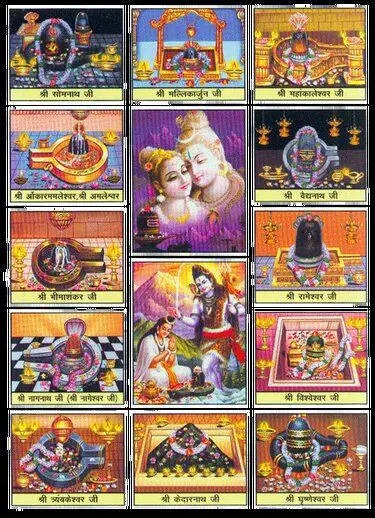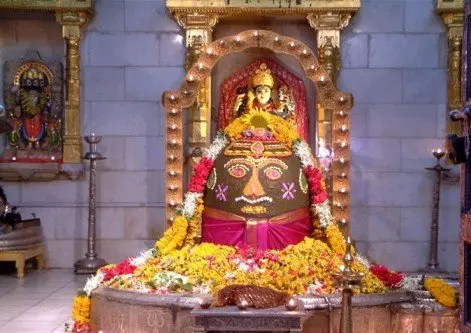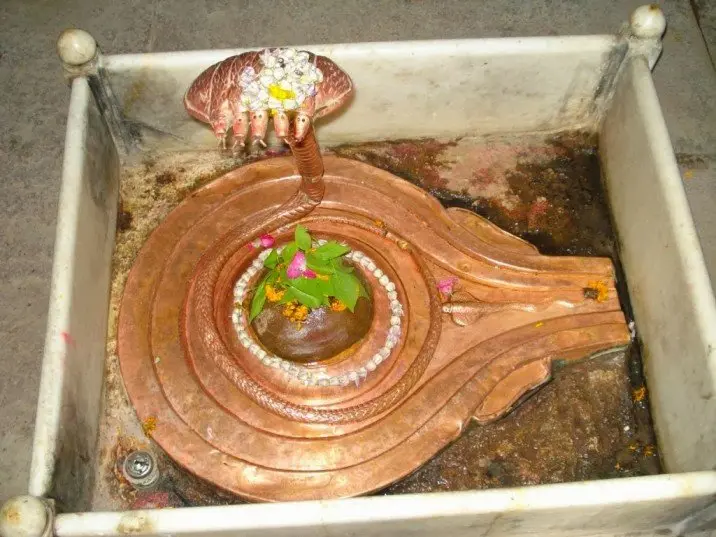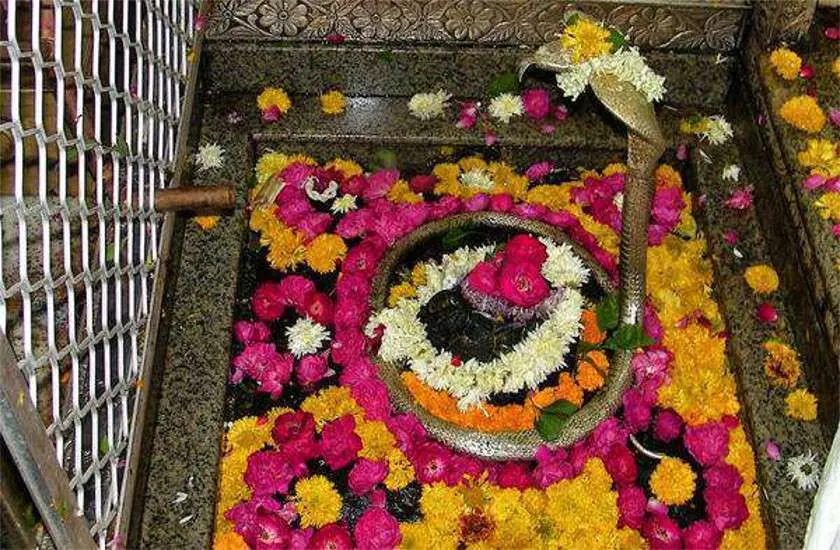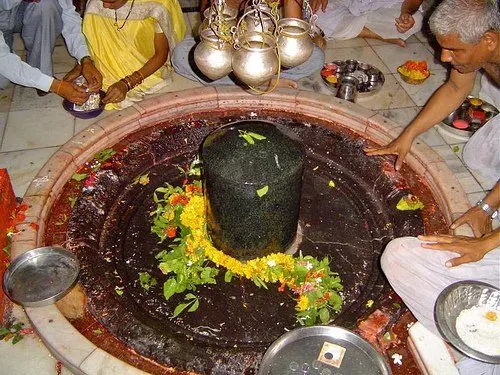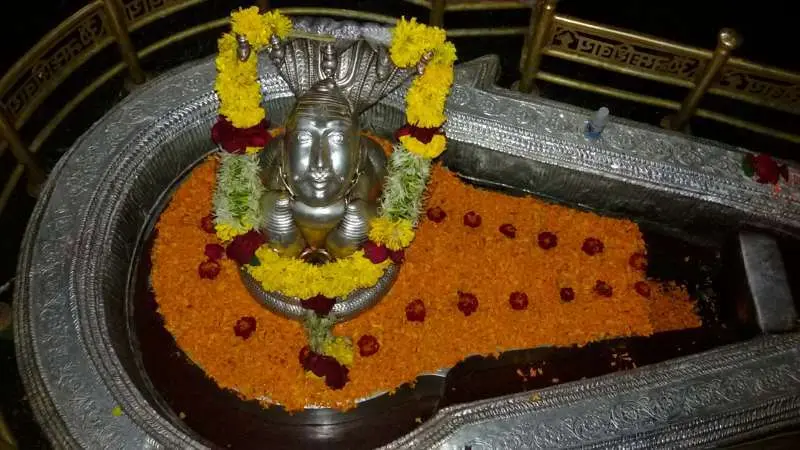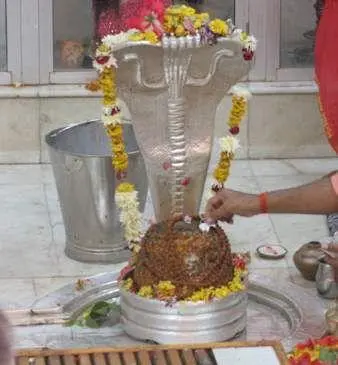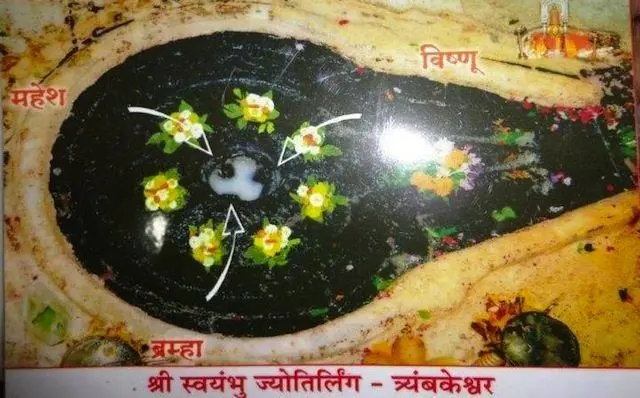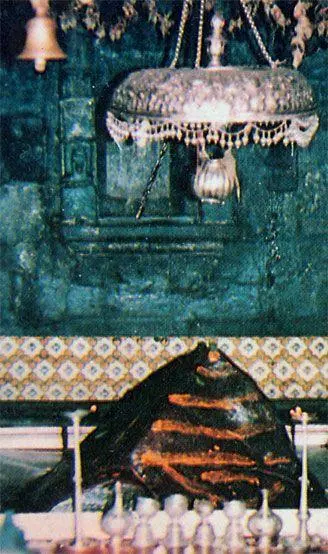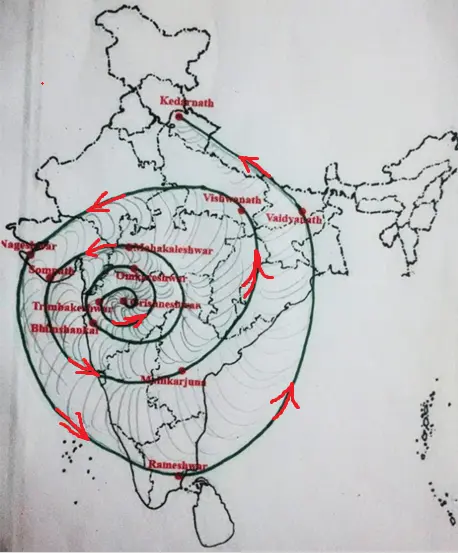The 12 Jyotirlingas are the 12 Shiva lingams in the 12 temples of Lord Shiva in India. Hindus believe that these are all swayambhu (self-manifested) Shiva lingams. They also believe that the Jyotirlingas are most sacred of all Shiva lingams.
What is a Jyotirlinga?
A Jyotirlinga is a cosmic pillar of fire that is the formless aspect of Lord Shiva. The word Jyoti has many different meanings, viz. flame of a lamp, light, radiance, brightness, etc. The word linga also has different meanings, but here it means “a symbol or sign.” Therefore, Jyotirlinga means “radiant sign of fire.”
How many Jyotirlingas are there?
The common belief is that originally there were 64 Jyotirlingas, but now there are only 12 Jyotirlingas in India.
Jyotirlinga as a Cosmic Pillar (The Story of Lingodbhava):
Once Lord Vishnu and Lord Brahma were arguing over superiority. The argument soon turned into a furious fight. Seeing this, the gods got scared and approached Lord Shiva to intervene. Lord Shiva appeared as a Jyotirlinga (cosmic pillar of light) between them and told them to find its end. One who would find the end first would be declared the greatest.
Therefore, Lord Vishnu took the form of a wild boar and traveled towards one end while Lord Brahma took the form of a swan and flew towards the other end. Even after a long time, both of them could not find its end and returned where they started. Lord Vishnu accepted that he could not find the end, but Lord Brahma, out of his arrogance, lied that he found the end of the pillar and presented the flower of Ketaki as a witness.
This made Lord Shiva angry, and he cut one of the five heads of Lord Brahma and cursed him not to be worshiped. He also banished the Ketaki flower from his worship. He declared that Lord Vishnu is superior to Lord Brahma and is equivalent to him (Shiva Purana, 4.23).
12 Jyotirlinga Names and Locations:
1. Somnath Jyotirlinga in Gir Somnath, Gujarat.
2. Mallikarjuna Jyotirlinga in Srisailam, Andhra Pradesh.
3. Mahakaleshwar Jyotirlinga in Ujjain, Madhya Pradesh.
4. Omkareshwar Jyotirlinga in Khandwa, Madhya Pradesh.
5. Baidyanath Jyotirlinga in Deoghar, Jharkhand.
6. Bhimashankar Jyotirlinga in Bhimashankar, Maharashtra.
7. Ramanathaswamy Jyotirlinga in Rameshwaram, Tamil Nadu.
8. Nageshwar Jyotirlinga in Dwarka, Gujarat.
9. Kashi Vishwanath Jyotirlinga in Varanasi, Uttar Pradesh.
10. Trimbakeshwar Jyotirlinga in Nashik, Maharashtra.
11. Kedarnath Jyotirlinga in Rudraprayag, Uttarakhand.
12. Grishneshwar Jyotirlinga in Aurangabad, Maharashtra.
12 Jyotirlinga Map:
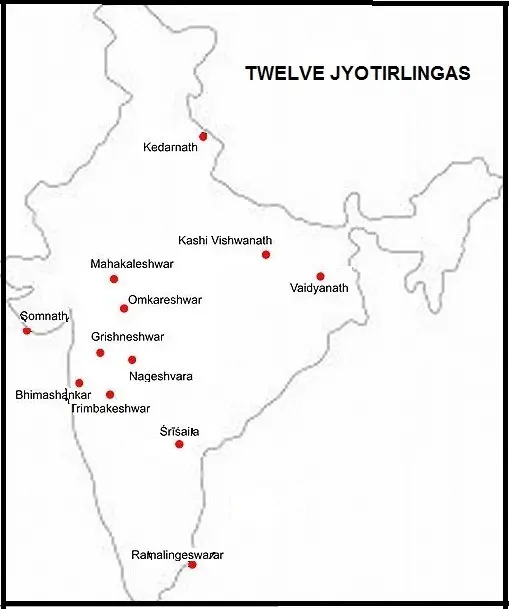
Image Credit: Softdynamite at English Wikipedia
The maximum number of Jyotirlinga, i.e., 3 are in Maharashtra, 2 are in Gujarat, 2 in Madhya Pradesh, and Uttar Pradesh, Uttarakhand, Tamil Nadu, Andhra Pradesh, and Jharkhand have 1 each.
The Sanskrit Shloka containing the names of 12 Jyotirlingas:
| सौराष्ट्रे सोमनाथं च श्रीशैले मल्लिकार्जुनम्। | Saurāṣṭre Somanāthaṃ ca Śrīśaile Mallikārjunam | Somanath in Saurashtra and Mallikarjunam in Shri-Shailam; |
| उज्जयिन्यां महाकालमोङ्कारममलेश्वरम्॥ | Ujjayinyāṃ Mahākālam Omkāram Mamleśhwaram | Mahakaal in Ujjain, Mamleshwar in Omkareshwar; |
| परल्यां वैद्यनाथं च डाकिन्यां भीमशङ्करम्। | Paralyāṃ Vaidyanāthaṃ cha Ḍākinyāṃ Bhīmaśhaṅkaram | Parali in Maharashtra and Bhimashankaram in Dakinya; |
| सेतुबन्धे तु रामेशं नागेशं दारुकावने॥ | Setubandhe tu Rāmeśaṃ Nāgeśhaṃ Dārukāvane | Ramesham (Rameshwaram) in Sethubandh, Nagesham in Daruka-Vana; |
| वाराणस्यां तु विश्वेशं त्र्यम्बकं गौतमीतटे। | Vārāṇasyāṃ tu Viśveśaṃ Tryambakaṃ Gautamītaṭe | Vishwesham (Vishvanath) in Vanarasi, Tryambakam at bank of the river Gautami (Godavari); |
| हिमालये तु केदारं घुश्मेशं च शिवालये॥ | Himālaye tu Kedāraṃ Ghuśmeśaṃ ca Śivālaye | Kedar in Himalayas and Ghushmesh (Ghushmeshwar) in Shivalaya. |
| एतानि ज्योतिर्लिङ्गानि सायं प्रातः पठेन्नरः। | etāni jyotirliṅgāni sāyaṃ prātaḥ paṭhennaraḥ | One who recites these Jyotirlingas every evening and morning |
| सप्तजन्मकृतं पापं स्मरणेन विनश्यति॥ | saptajanmakṛtaṃ pāpaṃ smaraṇena vinaśyati | is relieved of all sins committed in the past seven lives. |
| एतेशां दर्शनादेव पातकं नैव तिष्ठति। | eteśāṃ darśanādeva pātakaṃ naiva tiṣṭhati | One who visits these, gets all his wishes fulfilled |
| कर्मक्षयो भवेत्तस्य यस्य तुष्टो महेश्वराः॥: | karmakṣayo bhavettasya yasya tuṣṭo maheśvarāḥ | and one’s gets eliminated as Maheshwara gets satisfied with the worship. |
12 Jyotirlinga Temples, Images, and Stories:
1. Somnath Jyotirlinga:
It is the first of 12 Jyotirlingas in India. The Somnath Temple is located in Prabhas Patan in Saurashtra, Gujarat. It was desecrated and built many times. It was last reconstructed in 1950-51.
Somnath means “Lord of the Moon,” which is one of the names of Lord Shiva. We can find the story of Somnath Jyotirlinga in the Shiva Purana (4.14).
According to it, the Moon-god (Soma or Chandra) married 27 daughters of Daksha Prajapati, but he paid more attention to Rohini only. His other 26 wives complained to Daksha about this. Daksha told Moon-god to give equal attention to all his wives, but the Moon did not listen. The infuriated Daksha cursed him that he would fall prey to the wasting disease. Chandra’s body started wasting immediately, but this was diabolical for the world. Therefore, gods went to Lord Brahma for a solution, who in turn advised Chandra to worship in the form of a linga.
Chandra did penance for six months. Propitiated Lord Shiva appeared there in the form of a Jyotirlinga and blessed Chandra and reduced his curse. He told him that he would decline day by day in one fortnight and increase steadily in another. For increasing the glory of the region and the moon, Lord Shiva stayed there in the form of Someshwara.
2. Mallikarjuna Jyotirlinga:
It is situated at Srisailam in Andhra Pradesh. It is the only temple where both Lord Shiva and Goddess Parvati stayed in the form of a Jyotirlinga. In the remaining 11 Jyotirlinga, only Lord Shiva stayed there. It is also one of the 18 Shaktipeethas of Goddess Parvati. It is also known as the “Kailash of the South.”
According to the Shiva Purana (4.15), when Lord Kartikeya returned to Mount Kailash, Sage Narada informed him about the marriage of Lord Ganesha and corrupted his mind (Lord Ganesha is a younger brother of him, and he got upset because he was supposed to get married before him). Upset Kartikeya went to Mount Krauncha for ascetic practice against his parents’ advice. His distressed parents went there to convince him, but he went further out of disregard for their love. Lord Shiva and Goddess Parvati stayed behind assuming the fiery form. After this, Lord Shiva started visiting him on every no-moon day and Goddess Parvati on full-moon day.
3. Mahakaleshwar Jyotirlinga:
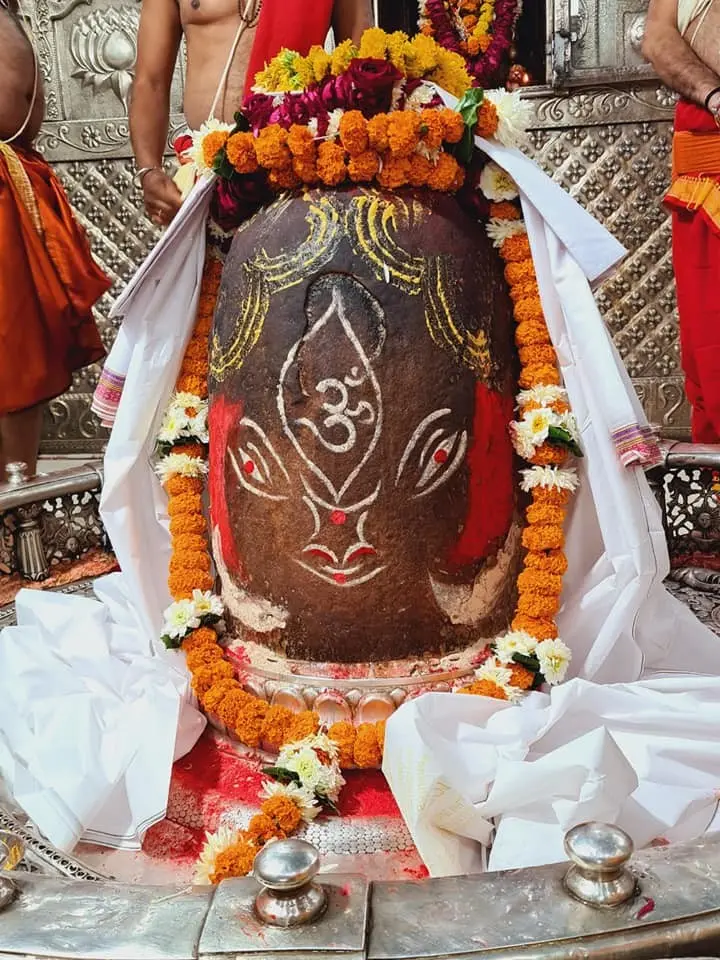
The Mahakaleshwar Temple is located in Ujjain, Madhya Pradesh. It is one of the seven Mukti-Sthala (liberation places) per the Hindu scriptures.
The story behind this Jyotirlinga is as follows (Shiva Purana, 4.16):
In the city Avanti, there lived a Brahmin named Priyamedhas and his four sons who were staunch devotees of Lord Shiva. Once a puissant Asura, Dusana, along with his great army attacked Avanti. But the Brahmin and his four sons were not afraid of him and performed worship of Lord Shiva in the form of a linga. On seeing this, Dusana ordered his people to kill them. When the Asuras desired to kill the Brahmins, a spot near the linga caved in with a loud report, and Lord Shiva rose in his Mahakala form. Then he reduced Dusana and his army to ashes with a mere sound of Hum. Propitiated by the devotion of the Brahmin and his sons, Lord Shiva asked the Brahmins to choose the boon they wished to have. Brahmins requested him to stay there to protect people. Lord Shiva accepted their request and stayed there.
4. Omkareshwar Jyotirlinga:
The Omkareshwar Temple is located in Khandwa, Madhya Pradesh on an island called Mandhata or Shivpuri in the Narmada River. Omkareshwar means “The Lord of Omkara.” The story of Omkareshwar Jyotirlinga is mentioned in the Shiva Purana (4.18).
One day, Sage Narada visited Vindhya mountain and found that it had become very arrogant. To dispel its pride, he told it that Mount Meru was loftier than it. Then Vindhya made a linga and started penance. After six months, propitiated Lord Shiva told him to ask for a boon he wished.
Vindhya asked for the intellect to achieve its object. Lord Shiva fulfilled his desire. After getting enlightenment, Vindhya came to know how petty his desire was and abstained from it. At this time, gods and sages requested Lord Shiva to stay there. Therefore, Lord Shiva stayed there for the happiness of the world.
5. Baidyanath Jyotirlinga:
The Baidyanath Temple is located in Deogarh in Jharkhand. It is also called Vaijnatha or Vaidyanath. There is some controversy related to the status of this Jyotirlinga as there are other two temples in India believed to be the real temple. The one is Vaidyanath Temple in Parli, Maharashtra and the other is The Baijnath Temple in Baijnath, Himachal Pradesh. Per Dwadasha Jyotirlinga Stotram, Vaidyanath in Parli, Maharashtra is the authentic Jyotirlinga.
To propitiate Lord Shiva, Ravana offered his 10 heads in the sacrificial fire. Therefore, to cure him Lord Shiva appeared here. Hence, this Jyotirlinga is known as Vaidyanath which means “Lord of the Doctors.”
According to another legend, Ravana asked for the image of Lord Shiva to take with him to Lanka. Lord Shiva granted him the boon with one condition that at whichever place he keeps the Shiva lingam, it would be fixed there. While coming back to Lanka, Ravana had a very strong desire of passing urine. He told a cowboy to hold the lingam for a while but did not return for a long time. Therefore, the cowboy put the lingam down and went away (Shiva Puran, 4.28). Some believe the cowboy was Lord Ganesha.
6. Bhimashankar Jyotirlinga:
The Bhimashankar Temple is located in the village Bhorgiri in Pune District, Maharashtra. The river Bhima also originates at this place. Bhima was an Asura on whose name this place got its name. We can find the story of Bhimashankar Jyotirlinga in the Shiva Purana (4.20).
Bhima was the son of Karkati and Kumbhakarna. He propitiated Brahma and asked for unequaled strength as a boon. Then, he defeated Indra and other gods in battle, including Lord Vishnu. Then he started conquering the Earth.
Sudakshina, the king of Kamapura, was a great devotee of Lord Shiva, but he was defeated by Bhima in a terrible battle. The king started a great meditation in front of the Shiva lingam. Then someone informed Bhima that the king was performing black magic against him. Infuriated, Bhima went to the king and tried to strike the Shiva lingam with his sword. The moment the sword touched the lingam, Lord Shiva manifested himself from the Shiva lingam and broke his sword. A fierce battle broke out between them. In the end, he reduced Bhima to ashes only with Hum sound.
Then the gods requested Lord Shiva to stay there for the welfare of people. Therefore, he stayed there in the form of a Jyotirlinga.
7. Rameshwaram Jyotirlinga:
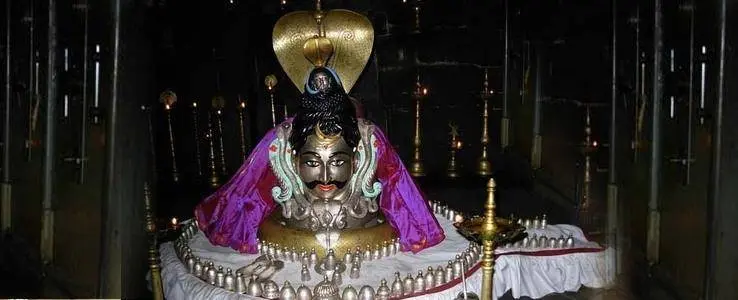
The Rameshwaram Temple is located on the island of Rameshwaram in Tamil Nadu.
According to the Shiva Purana (4.31), Lord Rama, Lakshmana, Hanuman, and the army of monkeys were assembled at the shore of the sea. They wanted to cross the ocean to defeat Ravana and get back Goddess Sita. He made a Shiva lingam there and worshiped Lord Shiva with devotion. Delighted by his worship, Lord Shiva appeared before him and told him to ask for a boon. Lord Rama requested for his victory in the imminent fight with Ravaṇa. He granted him the boon.
Then Lord Rama also requested him to stay there for the welfare of people. Therefore, Lord Shiva stayed there in the form of a Jyotirlinga named Rameshwara.
8. Nageshwara Jyotirlinga:
The Nageshwara Temple is located in Dwaraka, Gujarat. It is believed that worshiping this Jyotirling protects you from all types of poisons. When a demon and demoness abducted a great devotee of Lord Shiva and tried to kill him, Lord Shiva appeared here and killed all the demons. Lord Mahadeva stayed there in the form of a Jyotirlinga.
9. Kashi Vishwanath:
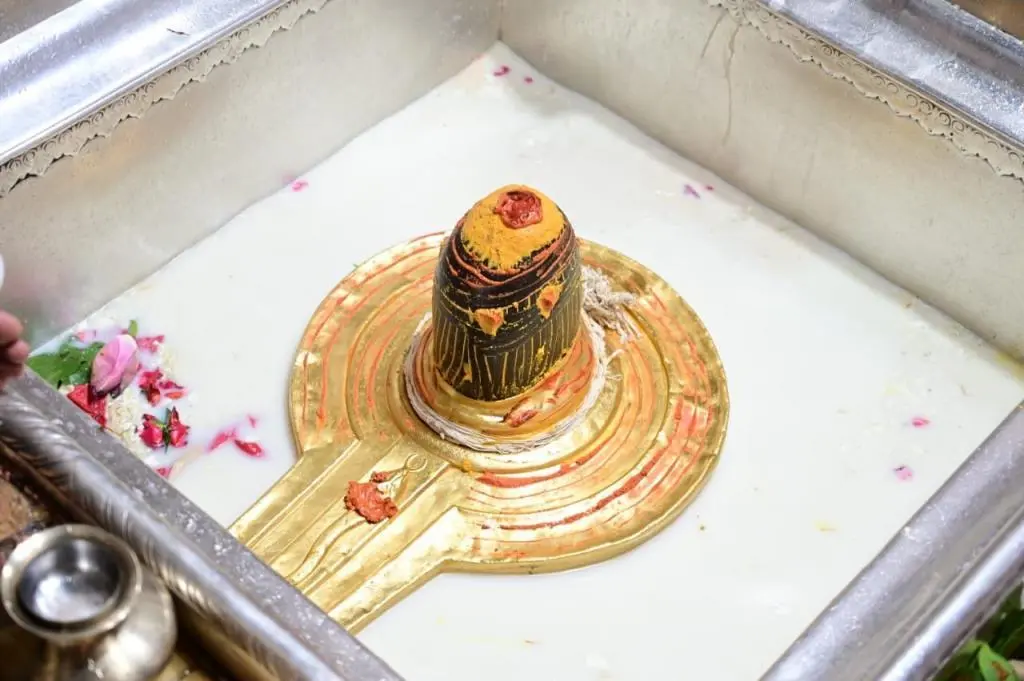
The Kashi Vishwanath Temple is the holiest place for Hindus. It is located in Varanasi, Uttar Pradesh. It is the most important Jyotirlinga. Hindus believe that the person who dies in Kashi attains salvation. Lord Shiva himself installed this Shiva lingam. Avimukta requested him to stay there along with Goddess Uma. Therefore, Lord Shiva stayed there in the form of the Jyotirlinga.
10. Trimbakeshwar Jyotirlinga:
The Trimbakeshwar Temple is located in Nashik, Maharashtra. It is also the source of the Godavari River, which is known as “Gautami Ganga.”
Lord Varuna blessed Sage Gautama with a pond with an inexhaustible source of water. Out of some misunderstanding and jealousy, other sages requested Lord Ganesha to help them expel the sage from the hermitage. After that, in an unfortunate event, Sage Gautama accidentally killed a cow. Taking advantage of this, other sages expel him and his wife from the hermitage.
He then propitiated Lord Shiva and asked for the River Ganges to come there. Ganga appeared there in the form of a lady and requested Lord Shiva to stay with her. Therefore, Lord Shiva stayed there in the form of Trimbakeshwar Jyotirlinga.
11. Kedarnath Jyotirlinga:
The Kedarnath Temple is located in Rudraprayag, Uttarakhand. This Jyotirlinga is shaped like a pyramid and is believed to be the hump of a bull/buffalo. It is one of the four Char Dham Yatra temples. In the year 2013, around 5000 people died in a flash flood here. The temple remains closed for six months in a year. The story of Kedarnath is like this (Shiva Purana, 4.19):
Nara and Narayana performed their penance in Badarikashrama. They requested Lord Shiva to come to the Shiva Lingam installed by them. Lord Shiva accepted their request and came every day to that linga. A long time elapsed in this way. On one occasion, Lord Shiva asked them to choose a boon they wished. They requested him to stay there in his form and accept the devotion of his devotees.
One day with some desires in mind, Pandavas came to Kedareshwara. On seeing them, Lord Shiva assumed the form of a buffalo and began to run away, but undeterred Pandavas caught him by the tail and implored him to grant their wishes. He stood there with his face bent down. His head portion went and remained fixed in the city of Nayapala. He asked them to worship him in that trunkless form. Pandavas did so and obtained what they desired. That is why the Shiva Lingam at Kedarnath is in a pyramid shape.
12. Ghrishneshwara Jyotirlinga:
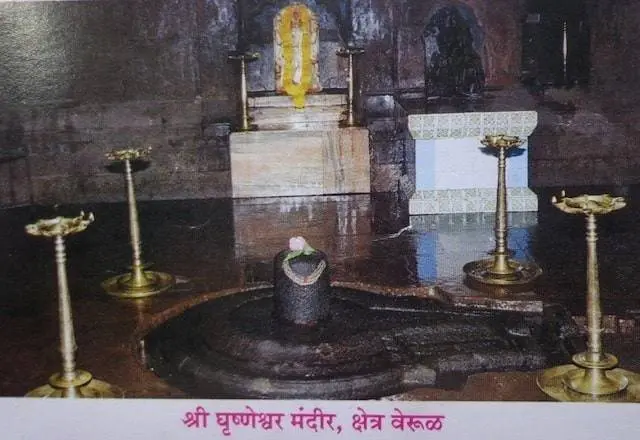
The Ghrishneshwar Temple is located in Verul, near Aurangabad in Maharashtra. It is just a few kilometers away from the Ellora caves. This temple was rebuilt by Ahilyadevi Holkar in the 18th century.
Sudeha and Sudharma were childless for a long time. Therefore, Sudharma married Sudeha’s sister Ghushma on her insistence. When Ghushma became the mother of a son, Sudeha became jealous of her and killed her son. He threw his body pieces into the lake into which Ghushma used to immerse the clay Shiva lingams daily. Even the death of her son did not deter Ghushma’s devotion toward Lord Shiva. She did not show any remorse. Lord Shiva was pleased by her devotion and rejuvenated her son. He also asked her if she wanted to punish her sister, but Ghushma forgave her. Therefore, Lord Shiva granted her a boon. Ghushma asked him to stay there in her name for the welfare of people. Therefore, this Jyotirlinga is called Ghrishneshwara or Ghushmeshwara.
Scientific Significance of 12 Jyotirlinga:
1. Hindus believe that India was created by gods. I think it means the Indian peninsula was modified by gods. According to a theory, once there were 12 active volcanoes in India, but gods nullified them and installed 12 Jyotirlingas on those spots so that no one would accidentally or deliberately activate them again. That is why these sites are sources of powerful energies. Also, that is why there are no volcanoes in India.
2. Some Hindus believe that 12 Jyotirlinga are radioactive, and there are radiations at all the sites.
3. Some people claim that Ujjain is the center of the Earth because it is located where the tropic of cancer and zero meridian of longitude intersect. Even today for astronomical calculations Ujjain’s time, which is 29 min, behind IST is considered best.
4. Joining all the 12 Jyotirlinga locations on the map results in a spiral pattern resembling Fibonacci series.
It is interesting to know that ancient Indian mathematicians knew the Fibonacci series. Sage Pingala’s work includes materials related to Fibonacci numbers, called Matrameru.
